How can a single plant cell seemingly “rewind time” and regenerate into a whole new plant? It sounds like science fiction, but researchers have now uncovered the science behind this incredible ability. In a groundbreaking study published in Cell on September 16, an international team from Shandong Agricultural University, Radboud University, State Key Laboratory of Genome and Multi-omics Technologies, and BGI-Research revealed how just two genes can reprogram a somatic plant cell into a totipotent one—capable of growing into an entirely new plant.
 The study “Time-Resolved Reprogramming of Single Somatic Cells into Totipotent States during Plant Regeneration” was published in Cell.
The study “Time-Resolved Reprogramming of Single Somatic Cells into Totipotent States during Plant Regeneration” was published in Cell.
The team identified two key transcription factors, LEC2 (LEAFY COTYLEDON2) and SPCH (SPEECHLESS), that act as genetic switches to kickstart this transformation. When activated, these genes trigger the TAA1/YUC auxin biosynthesis pathway, ramping up production of auxin—a vital plant hormone that drives cellular reprogramming. Under auxin’s influence, cells in the cotyledon epidermis, which normally develop into stomata (tiny pores on the leaf surface), are rerouted to become somatic embryo founder cells (SEFCs). These SEFCs are totipotent, meaning they have the remarkable ability to regenerate an entire plant from scratch.
LEC2-induced somatic embryos originate from single cotyledon epidermal cells.
What sets this discovery apart is that it bypasses the usual callus stage. Instead, the process moves straight into somatic embryogenesis, making plant regeneration faster and more efficient than previously imagined.
To understand this transformation in detail, the researchers used high-resolution single-cell sequencing powered by BGI Group’s cutting-edge technology. By analyzing over 70,000 plant cell nuclei, they built a detailed map of gene expression changes during regeneration. This analysis led to the discovery of a key transitional phase called the “GMC-auxin intermediate state.” In this state, cells accumulate auxin, undergo significant chromatin remodeling (changes in DNA packaging), and activate dormant embryonic genes. This allows cells to essentially “reset” their identity, switching from a specialized role—like forming part of a leaf—to becoming a totipotent cell capable of creating an entire plant.
Chromatin remodeling turned out to be a crucial part of the puzzle. By modifying the epigenetic landscape, previously inaccessible genes become activated, allowing the transformation to take place. LEC2 and SPCH work together in this process, forming a powerful regulatory duo that ensures auxin production is both strong and localized—making the reprogramming process highly efficient and precise.
Single-nucleus transcriptomics reveal LEC2-induced cell fate transitions and lineage reprogramming toward somatic embryogenesis.
The implications of this discovery go far beyond the lab. In agriculture, it opens up the possibility of cloning elite crop varieties directly from single cells—drastically reducing breeding time and costs. It could also help conserve rare or endangered plant species by enabling large-scale propagation. And with the growing challenges of climate change, the ability to quickly regenerate high-yield, resilient crops could be a game-changer for global food security.
Interestingly, the study also shows that stomatal lineage cells—those expressing SPCH—are far more flexible than previously thought. They can switch developmental tracks entirely, offering a new model for understanding cellular plasticity, not just in plants, but possibly in other life forms as well.
Looking ahead, scientists hope to explore whether this genetic reprogramming method can be applied to other plant species, especially important crops. The goal is clear - faster breeding, greater productivity, and the large-scale production of valuable or rare plants. And while the research is plant-focused, the insights into chromatin remodeling and cellular reprogramming could one day influence breakthroughs in regenerative medicine—like organ repair or tissue regeneration in humans.
This study can be accessed here:
https://www.cell.com/cell/fulltext/S0092-8674(25)01020-7?rss=yes



